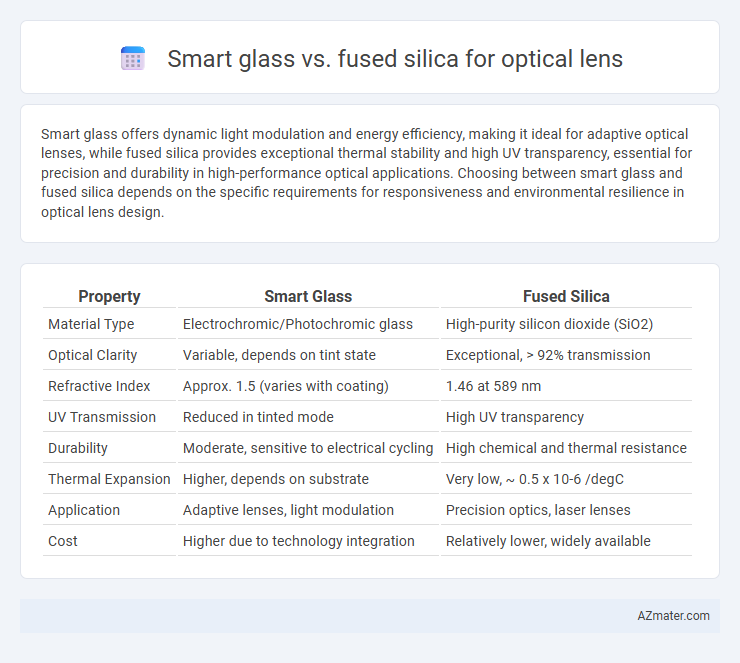Smart glass offers dynamic light modulation and energy efficiency, making it ideal for adaptive optical lenses, while fused silica provides exceptional thermal stability and high UV transparency, essential for precision and durability in high-performance optical applications. Choosing between smart glass and fused silica depends on the specific requirements for responsiveness and environmental resilience in optical lens design.
Table of Comparison
| Property | Smart Glass | Fused Silica |
|---|---|---|
| Material Type | Electrochromic/Photochromic glass | High-purity silicon dioxide (SiO2) |
| Optical Clarity | Variable, depends on tint state | Exceptional, > 92% transmission |
| Refractive Index | Approx. 1.5 (varies with coating) | 1.46 at 589 nm |
| UV Transmission | Reduced in tinted mode | High UV transparency |
| Durability | Moderate, sensitive to electrical cycling | High chemical and thermal resistance |
| Thermal Expansion | Higher, depends on substrate | Very low, ~ 0.5 x 10-6 /degC |
| Application | Adaptive lenses, light modulation | Precision optics, laser lenses |
| Cost | Higher due to technology integration | Relatively lower, widely available |
Overview of Smart Glass and Fused Silica
Smart glass utilizes electrochromic, photochromic, or thermochromic technologies to dynamically control light transmission, enhancing privacy and energy efficiency in optical lenses. Fused silica, a high-purity synthetic quartz, offers exceptional optical clarity, thermal stability, and resistance to chemical corrosion, making it ideal for precision lenses in scientific and industrial applications. Both materials serve distinct purposes; smart glass adapts to changing light conditions, while fused silica provides superior durability and optical performance under extreme environments.
Material Composition and Properties
Smart glass for optical lenses typically consists of liquid crystal or electrochromic materials embedded within glass substrates, enabling dynamic control of light transmission and opacity. Fused silica, a high-purity silicon dioxide material, exhibits exceptional optical clarity, thermal stability, and low thermal expansion, making it ideal for high-precision optical applications. While smart glass prioritizes functionality with variable transparency properties, fused silica emphasizes durability, chemical resistance, and superior light transmission across UV to IR spectrums.
Optical Clarity and Transparency Comparison
Smart glass offers variable opacity but typically exhibits slightly reduced optical clarity compared to fused silica, which is renowned for its exceptional transparency and minimal light distortion. Fused silica's high purity and low thermal expansion provide superior transmission across UV to IR wavelengths, making it ideal for precision optical lenses. In contrast, smart glass materials can introduce subtle haze or color shifts when activated, affecting overall transparency and sharpness.
Light Transmission and Refraction
Smart glass offers variable light transmission controlled by electrical signals, enabling dynamic modulation of transparency and minimizing glare in optical lenses. Fused silica provides exceptionally high light transmission across ultraviolet to infrared wavelengths and maintains a low refractive index around 1.46, ensuring minimal light distortion and superior optical clarity. The refractive index of smart glass varies depending on its composition, typically ranging between 1.4 and 1.6, but fused silica remains preferred for precision optics due to its consistent optical properties and low thermal expansion.
Durability and Scratch Resistance
Smart glass offers enhanced scratch resistance due to its specialized coatings and flexible polymer layers, making it more durable under everyday wear and tear compared to traditional optical materials. Fused silica exhibits superior hardness and thermal stability, providing exceptional durability in high-temperature and harsh environmental conditions but is more prone to surface scratches if not coated properly. Choosing between smart glass and fused silica depends on the specific application requirements for durability against mechanical abrasion versus thermal and chemical resistance.
Thermal Stability and Temperature Resistance
Smart glass offers variable opacity control but generally has lower thermal stability compared to fused silica, which excels in maintaining optical clarity under high temperatures. Fused silica lenses demonstrate exceptional temperature resistance, withstanding thermal fluctuations up to 1200degC without deformation or loss of optical properties. This makes fused silica the preferred material for precision optics in harsh thermal environments where consistent performance is critical.
UV and Infrared Performance
Smart glass offers dynamic control over light transmission, making it effective for UV protection by adjusting opacity, but it often exhibits limited infrared (IR) transparency compared to fused silica. Fused silica, a high-purity silicon dioxide material, provides exceptional UV transmission down to 180 nm and superior infrared transmission up to 3.5 microns, making it ideal for high-performance optical lenses requiring broad-spectrum clarity. Its low thermal expansion and high resistance to UV-induced degradation outperform smart glass, which can suffer from decreased durability under intense UV and IR exposure.
Cost-Effectiveness and Availability
Smart glass offers enhanced functionality with variable transparency but tends to have higher initial costs and limited availability compared to fused silica. Fused silica provides superior optical clarity, durability, and widespread availability at a lower cost, making it more cost-effective for standard optical lens applications. For projects prioritizing budget and consistent supply, fused silica remains the preferred choice over smart glass.
Common Applications in Optical Lenses
Smart glass in optical lenses is widely used for adjustable tinting in eyewear, automotive windows, and architectural applications, providing dynamic control over light transmission. Fused silica, known for its exceptional thermal stability and low optical dispersion, is preferred in high-precision laser optics, microscopy lenses, and UV-grade optical components. While smart glass enhances user comfort and energy efficiency, fused silica delivers superior optical clarity and durability in demanding scientific and industrial environments.
Choosing the Right Material for Your Needs
Smart glass offers dynamic light modulation and energy efficiency ideal for adaptive optical lenses, while fused silica provides superior optical clarity, thermal stability, and UV resistance crucial for precision applications. Selecting the right material depends on factors like environmental conditions, required durability, and specific optical performance, with smart glass excelling in smart windows and filters, and fused silica preferred for high-precision scientific or industrial lenses. Evaluating application-specific needs ensures optimal lens functionality, balancing innovation with material properties for best results.

Infographic: Smart glass vs Fused silica for Optical lens
 azmater.com
azmater.com